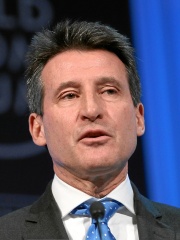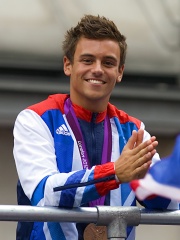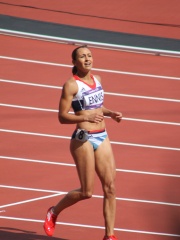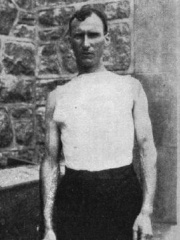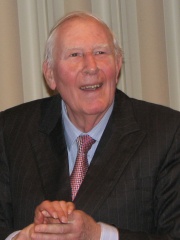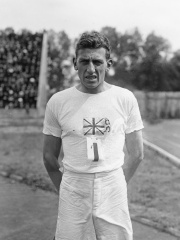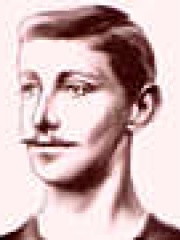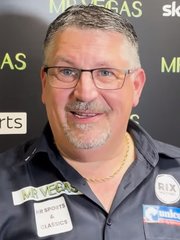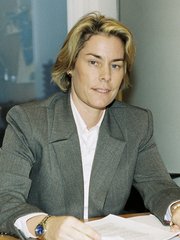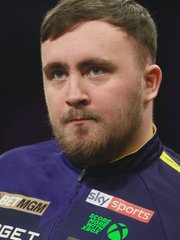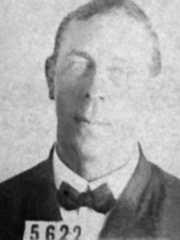
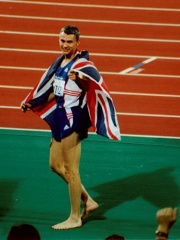
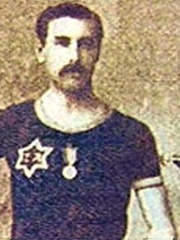
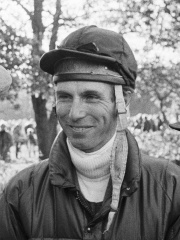
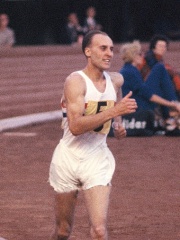
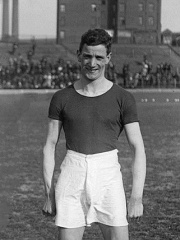

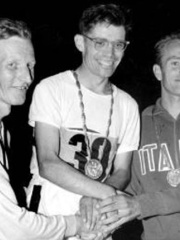
The Most Famous
ATHLETES from United Kingdom
This page contains a list of the greatest British Athletes. The pantheon dataset contains 6,025 Athletes, 596 of which were born in United Kingdom. This makes United Kingdom the birth place of the 4th most number of Athletes behind Germany, and Russia.
Top 10
The following people are considered by Pantheon to be the top 10 most legendary British Athletes of all time. This list of famous British Athletes is sorted by HPI (Historical Popularity Index), a metric that aggregates information on a biography's online popularity. Visit the rankings page to view the entire list of British Athletes.

1. Robert Hichens (1882 - 1940)
With an HPI of 67.59, Robert Hichens is the most famous British Athlete. His biography has been translated into 19 different languages on wikipedia.
Robert Hichens (16 September 1882 – 23 September 1940) was a British sailor who was part of the deck crew on board the RMS Titanic when she sank on her maiden voyage on 15 April 1912. He was one of seven quartermasters on board the vessel and was at the ship's wheel when the Titanic struck the iceberg. He was in charge of Lifeboat No. 6, where he refused to return to rescue people from the water due to fear of the boat being sucked into the ocean with the huge suction created by the Titanic, or swamped by other floating passengers. According to several accounts of those on the boat, including Margaret Brown, who argued with him throughout the early morning, Lifeboat 6 did not return to save other passengers from the waters. In 1906, he married Florence Mortimore in Devon, England; when he registered for duty aboard the Titanic, his listed address was in Southampton, where he lived with his wife and two children.

2. Jonathan Edwards (b. 1966)
With an HPI of 65.48, Jonathan Edwards is the 2nd most famous British Athlete. His biography has been translated into 38 different languages.
Jonathan David Edwards (born 10 May 1966) is an English former triple jumper. He is an Olympic, double World, European, European indoor and Commonwealth champion, and has held the world record in the event since 1995. Edwards is regarded as one of the greatest triple-jumpers in history. Following his retirement as an athlete, Edwards has worked as a sports (primarily athletics) commentator and presenter for BBC television, before moving to Eurosport. In 2011, he was elected President of the Wenlock Olympian Society. He was a member of the London Organising Committee of the Olympic and Paralympic Games for the 2012 games.

3. Charles Bennett (1870 - 1950)
With an HPI of 64.54, Charles Bennett is the 3rd most famous British Athlete. His biography has been translated into 23 different languages.
Charles Bennett (9 December 1871 – 18 December 1948) was a British athlete, winner of the 1500 metres at the 1900 Summer Olympics and the first British track and field athlete to become Olympic champion. He was a member of Finchley Harriers (founded 1877) which was amalgamated into Hillingdon Athletic Club in 1966.

4. Mark Phillips (b. 1948)
With an HPI of 63.74, Mark Phillips is the 4th most famous British Athlete. His biography has been translated into 30 different languages.
Mark Anthony Peter Phillips (born 22 September 1948) is an English Olympic gold medal-winning horseman for Great Britain and the first husband of Anne, Princess Royal, with whom he has two children. He remains a leading figure in British equestrian circles, a noted eventing course designer, and a columnist for Horse & Hound magazine.
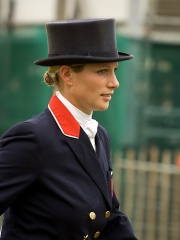
5. Zara Tindall (b. 1981)
With an HPI of 63.55, Zara Tindall is the 5th most famous British Athlete. Her biography has been translated into 38 different languages.
Zara Anne Elizabeth Tindall (née Phillips; born 15 May 1981) is a British equestrian, Olympian, and member of the British royal family. She is the daughter of Anne, Princess Royal, and Captain Mark Phillips, and eldest niece of King Charles III. At birth she was sixth in the line of succession to the British throne during the reign of her maternal grandmother, Queen Elizabeth II, and as of 2025 is 22nd. Tindall won the individual eventing world title at Aachen in 2006 and was named BBC Sports Personality of the Year. In 2011 she married former rugby union player Mike Tindall; they have three children. The following year she carried the Olympic flame at Cheltenham Racecourse on her horse Toytown, and later won a team silver medal in eventing at the 2012 London Summer Olympics, presented to her by her mother.

6. Ken Matthews (1934 - 2019)
With an HPI of 62.93, Ken Matthews is the 6th most famous British Athlete. His biography has been translated into 22 different languages.
Kenneth Joseph Matthews, MBE (21 June 1934 – 2 June 2019) was a British race walker, who won the Olympic (1964) and European (1962) titles in the 20 km walk.

7. David Jacobs (1888 - 1976)
With an HPI of 62.82, David Jacobs is the 7th most famous British Athlete. His biography has been translated into 19 different languages.
David Henry Jacobs (30 April 1888 – 6 June 1976) was a Welsh-born track and field sprinter. He was the first British Jew to win an Olympic gold medal.

8. John Rimmer (1878 - 1962)
With an HPI of 62.30, John Rimmer is the 8th most famous British Athlete. His biography has been translated into 20 different languages.
John Thomas Rimmer (27 April 1878 – 6 June 1962) was a British athlete, winner of two gold medals at the 1900 Summer Olympics. Rimmer won the AAA Championships in 4 miles (6.4 km) at the 1900 AAA Championships. He was born in Birkdale, Merseyside. With two, he jointly held the record for the most Olympic titles in athletics by a British athlete.

9. Don Thompson (1933 - 2006)
With an HPI of 62.08, Don Thompson is the 9th most famous British Athlete. Her biography has been translated into 20 different languages.
Donald James Thompson MBE (20 January 1933 – 3 October 2006) was an English racewalker. He was the only British man to win a gold medal at the 1960 Summer Olympics, in the 50 km walk. He also won a bronze medal at the 1962 European Championships, also for the 50 km walk.

10. George S. Robertson (1872 - 1967)
With an HPI of 61.75, George S. Robertson is the 10th most famous British Athlete. His biography has been translated into 25 different languages.
Sir George Stuart Robertson (25 May 1872 – 29 January 1967) was a British barrister, public servant, athlete, tennis player, and classical scholar. He competed at the 1896 Summer Olympics in Athens.
People
Pantheon has 596 people classified as British athletes born between 1703 and 2007. Of these 596, 504 (84.56%) of them are still alive today. The most famous living British athletes include Jonathan Edwards, Mark Phillips, and Zara Tindall. The most famous deceased British athletes include Robert Hichens, Charles Bennett, and Ken Matthews. As of April 2024, 68 new British athletes have been added to Pantheon including Gary Anderson, Leroy Watson, and Theresa Zabell.
Living British Athletes
Go to all RankingsJonathan Edwards
1966 - Present
HPI: 65.48
Mark Phillips
1948 - Present
HPI: 63.74
Zara Tindall
1981 - Present
HPI: 63.55
Sebastian Coe
1956 - Present
HPI: 60.39
Ian Stewart
1949 - Present
HPI: 56.72
Dorian Yates
1962 - Present
HPI: 56.56
Tom Daley
1994 - Present
HPI: 55.99
Jessica Ennis-Hill
1986 - Present
HPI: 54.50
Sonia Robertson
1947 - Present
HPI: 54.47
Heather Oakes
1959 - Present
HPI: 53.29
Sheila Lerwill
1928 - Present
HPI: 52.63
Peter Wright
1970 - Present
HPI: 52.42
Deceased British Athletes
Go to all RankingsRobert Hichens
1882 - 1940
HPI: 67.59
Charles Bennett
1870 - 1950
HPI: 64.54
Ken Matthews
1934 - 2019
HPI: 62.93
David Jacobs
1888 - 1976
HPI: 62.82
John Rimmer
1878 - 1962
HPI: 62.30
Don Thompson
1933 - 2006
HPI: 62.08
George S. Robertson
1872 - 1967
HPI: 61.75
Thomas Hicks
1876 - 1952
HPI: 61.38
Roger Bannister
1929 - 2018
HPI: 60.24
Harold Abrahams
1899 - 1978
HPI: 60.18
Bill Roberts
1912 - 2001
HPI: 60.15
Alfred Tysoe
1874 - 1901
HPI: 59.88
Newly Added British Athletes (2025)
Go to all RankingsGary Anderson
1970 - Present
HPI: 45.46
Leroy Watson
1965 - Present
HPI: 44.41
Theresa Zabell
1965 - Present
HPI: 42.50
Steven Hallard
1965 - Present
HPI: 42.36
Phylis Smith
1965 - Present
HPI: 42.31
Margaret Morton
1968 - Present
HPI: 42.30
Sean Olsson
1967 - Present
HPI: 41.81
Michelle Scutt
1960 - Present
HPI: 41.54
Luke Littler
2007 - Present
HPI: 39.24
Peter Charles
1960 - Present
HPI: 39.09
Ian Wynne
1973 - Present
HPI: 39.04
Campbell Walsh
1977 - Present
HPI: 38.86
Overlapping Lives
Which Athletes were alive at the same time? This visualization shows the lifespans of the 25 most globally memorable Athletes since 1700.

